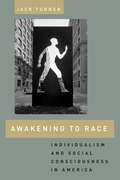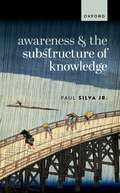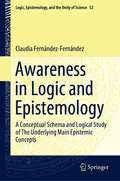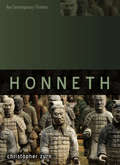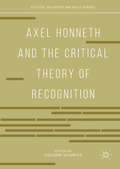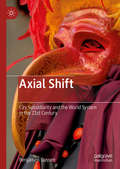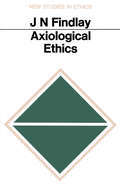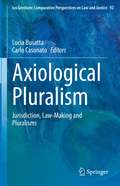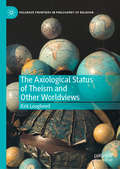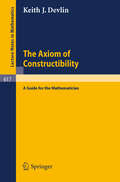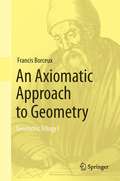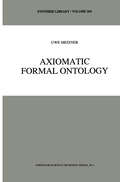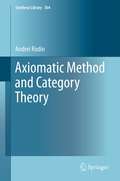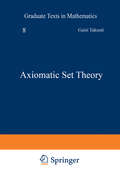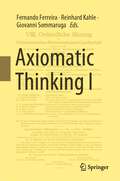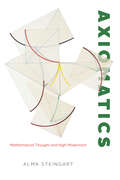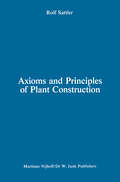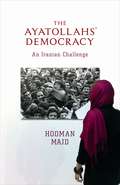- Table View
- List View
Awakening to Race: Individualism and Social Consciousness in America
by Jack TurnerThe election of America’s first black president has led many to believe that race is no longer a real obstacle to success and that remaining racial inequality stems largely from the failure of minority groups to take personal responsibility for seeking out opportunities. Often this argument is made in the name of the long tradition of self-reliance and American individualism. In Awakening to Race, Jack Turner upends this view, arguing that it expresses not a deep commitment to the values of individualism, but a narrow understanding of them. Drawing on the works of Ralph Waldo Emerson, Henry David Thoreau, Frederick Douglass, Ralph Ellison, and James Baldwin, Turner offers an original reconstruction of democratic individualism in American thought. All these thinkers, he shows, held that personal responsibility entails a refusal to be complicit in injustice and a duty to combat the conditions and structures that support it. At a time when individualism is invoked as a reason for inaction, Turner makes the individualist tradition the basis of a bold and impassioned case for race consciousness—consciousness of the ways that race continues to constrain opportunity in America. Turner’s “new individualism” becomes the grounds for concerted public action against racial injustice.
Awakening to Race: Individualism and Social Consciousness in America
by Jack TurnerThe election of America’s first black president has led many to believe that race is no longer a real obstacle to success and that remaining racial inequality stems largely from the failure of minority groups to take personal responsibility for seeking out opportunities. Often this argument is made in the name of the long tradition of self-reliance and American individualism. In Awakening to Race, Jack Turner upends this view, arguing that it expresses not a deep commitment to the values of individualism, but a narrow understanding of them. Drawing on the works of Ralph Waldo Emerson, Henry David Thoreau, Frederick Douglass, Ralph Ellison, and James Baldwin, Turner offers an original reconstruction of democratic individualism in American thought. All these thinkers, he shows, held that personal responsibility entails a refusal to be complicit in injustice and a duty to combat the conditions and structures that support it. At a time when individualism is invoked as a reason for inaction, Turner makes the individualist tradition the basis of a bold and impassioned case for race consciousness—consciousness of the ways that race continues to constrain opportunity in America. Turner’s “new individualism” becomes the grounds for concerted public action against racial injustice.
Awareness and the Substructure of Knowledge
by Paul Silva JrTo say that someone is aware of a fact is a commonplace expression, not at all a philosopher's term of art. It is often used to criticize, excuse, admonish, and inform others. Such uses of the expression presuppose the existence of a state of awareness that one can be in or fail to be in with regard to some fact. Here lies the phenomenon of factual awareness. It is conventional in epistemology to treat 'S is aware of the fact that p' as either expressing the same thought as 'S knows that p' or at least entailing it. Learning of the failure of conventional views is often both surprising and theoretically fruitful. This book presents a comprehensive case against the view that factual awareness just is knowledge or even essentially related to knowledge: factual awareness is not identical to, and it does not entail, knowing, being in a position to know, or being capable of knowing. It provides a systematic exploration of the relation between knowledge and factual awareness, arguing that knowledge is but one species of factual awareness and that we can understand the possession of objective reasons, the normativity of knowledge, and the nature of knowledge in terms of factual awareness. In this way, the state of factual awareness is, structurally and substantively, a more basic type of state than knowledge. If correct, this undermines a number of ways in which knowledge has been regarded as coming 'first' in recent epistemology.
Awareness and the Substructure of Knowledge
by Paul Silva JrTo say that someone is aware of a fact is a commonplace expression, not at all a philosopher's term of art. It is often used to criticize, excuse, admonish, and inform others. Such uses of the expression presuppose the existence of a state of awareness that one can be in or fail to be in with regard to some fact. Here lies the phenomenon of factual awareness. It is conventional in epistemology to treat 'S is aware of the fact that p' as either expressing the same thought as 'S knows that p' or at least entailing it. Learning of the failure of conventional views is often both surprising and theoretically fruitful. This book presents a comprehensive case against the view that factual awareness just is knowledge or even essentially related to knowledge: factual awareness is not identical to, and it does not entail, knowing, being in a position to know, or being capable of knowing. It provides a systematic exploration of the relation between knowledge and factual awareness, arguing that knowledge is but one species of factual awareness and that we can understand the possession of objective reasons, the normativity of knowledge, and the nature of knowledge in terms of factual awareness. In this way, the state of factual awareness is, structurally and substantively, a more basic type of state than knowledge. If correct, this undermines a number of ways in which knowledge has been regarded as coming 'first' in recent epistemology.
Awareness in Logic and Epistemology: A Conceptual Schema and Logical Study of The Underlying Main Epistemic Concepts (Logic, Epistemology, and the Unity of Science #52)
by Claudia Fernández-FernándezThis book creates a conceptual schema that acts as a correlation between Epistemology and Epistemic Logic. It connects both fields and offers a proper theoretical foundation for the contemporary developments of Epistemic Logic regarding the dynamics of information. It builds a bridge between the view of Awareness Justification Internalism, and a dynamic approach to Awareness Logic. The book starts with an introduction to the main topics in Epistemic Logic and Epistemology and reviews the disconnection between the two fields. It analyses three core notions representing the basic structure of the conceptual schema: “Epistemic Awareness”, “Knowledge” and “Justification”. Next, it presents the Explicit Aware Knowledge (EAK) Schema, using a diagram of three ellipses to illustrate the schema, and a formal model based on a neighbourhood-model structure, that shows one concrete application of the EAK-Schema into a logical structure. The book ends by presenting conclusions and final remarks about the uses and applications of the EAK-Schema. It shows that the most important feature of the schema is that it serves both as a theoretical correlate to the dynamic extensions of Awareness Logic, providing it with a philosophical background, and as an abstract conceptual structure for a re-interpretation of Epistemology.
An Awareness of What is Missing: Faith and Reason in a Post-secular Age
by Jürgen HabermasIn his recent writings on religion and secularization, Habermas has challenged reason to clarify its relation to religious experience and to engage religions in a constructive dialogue. Given the global challenges facing humanity, nothing is more dangerous than the refusal to communicate that we encounter today in different forms of religious and ideological fundamentalism. Habermas argues that in order to engage in this dialogue, two conditions must be met: religion must accept the authority of secular reason as the fallible results of the sciences and the universalistic egalitarianism in law and morality; and conversely, secular reason must not set itself up as the judge concerning truths of faith. This argument was developed in part as a reaction to the conception of the relation between faith and reason formulated by Pope Benedict XVI in his 2006 Regensburg address. In 2007 Habermas conducted a debate, under the title ‘An Awareness of What Is Missing', with philosophers from the Jesuit School for Philosophy in Munich. This volume includes Habermas's essay, the contributions of his interlocutors and Habermas's reply to them. It will be indispensable reading for anyone who wishes to understand one of the most urgent and intractable issues of our time.
An Awareness of What is Missing: Faith and Reason in a Post-secular Age
by Jürgen HabermasIn his recent writings on religion and secularization, Habermas has challenged reason to clarify its relation to religious experience and to engage religions in a constructive dialogue. Given the global challenges facing humanity, nothing is more dangerous than the refusal to communicate that we encounter today in different forms of religious and ideological fundamentalism. Habermas argues that in order to engage in this dialogue, two conditions must be met: religion must accept the authority of secular reason as the fallible results of the sciences and the universalistic egalitarianism in law and morality; and conversely, secular reason must not set itself up as the judge concerning truths of faith. This argument was developed in part as a reaction to the conception of the relation between faith and reason formulated by Pope Benedict XVI in his 2006 Regensburg address. In 2007 Habermas conducted a debate, under the title ‘An Awareness of What Is Missing', with philosophers from the Jesuit School for Philosophy in Munich. This volume includes Habermas's essay, the contributions of his interlocutors and Habermas's reply to them. It will be indispensable reading for anyone who wishes to understand one of the most urgent and intractable issues of our time.
Axel Honneth (Key Contemporary Thinkers)
by Christopher ZurnWith his insightful and wide-ranging theory of recognition, Axel Honneth has decisively reshaped the Frankfurt School tradition of critical social theory. Combining insights from philosophy, sociology, psychology, history, political economy, and cultural critique, Honneth’s work proposes nothing less than an account of the moral infrastructure of human sociality and its relation to the perils and promise of contemporary social life. This book provides an accessible overview of Honneth’s main contributions across a variety of fields, assessing the strengths and weaknesses of his thought. Christopher Zurn clearly explains Honneth’s multi-faceted theory of recognition and its relation to diverse topics: individual identity, morality, activist movements, progress, social pathologies, capitalism, justice, freedom, and critique. In so doing, he places Honneth’s theory in a broad intellectual context, encompassing classic social theorists such as Kant, Hegel, Marx, Freud, Dewey, Adorno and Habermas, as well as contemporary trends in social theory and political philosophy. Treating the full range of Honneth’s corpus, including his major new work on social freedom and democratic ethical life, this book is the most up-to-date guide available. Axel Honneth will be invaluable to students and scholars working across the humanities and social sciences, as well as anyone seeking a clear guide to the work of one of the most influential theorists writing today.
Axel Honneth (Key Contemporary Thinkers)
by Christopher ZurnWith his insightful and wide-ranging theory of recognition, Axel Honneth has decisively reshaped the Frankfurt School tradition of critical social theory. Combining insights from philosophy, sociology, psychology, history, political economy, and cultural critique, Honneth’s work proposes nothing less than an account of the moral infrastructure of human sociality and its relation to the perils and promise of contemporary social life. This book provides an accessible overview of Honneth’s main contributions across a variety of fields, assessing the strengths and weaknesses of his thought. Christopher Zurn clearly explains Honneth’s multi-faceted theory of recognition and its relation to diverse topics: individual identity, morality, activist movements, progress, social pathologies, capitalism, justice, freedom, and critique. In so doing, he places Honneth’s theory in a broad intellectual context, encompassing classic social theorists such as Kant, Hegel, Marx, Freud, Dewey, Adorno and Habermas, as well as contemporary trends in social theory and political philosophy. Treating the full range of Honneth’s corpus, including his major new work on social freedom and democratic ethical life, this book is the most up-to-date guide available. Axel Honneth will be invaluable to students and scholars working across the humanities and social sciences, as well as anyone seeking a clear guide to the work of one of the most influential theorists writing today.
Axel Honneth and the Critical Theory of Recognition (Political Philosophy and Public Purpose)
by Volker SchmitzThe critical theory of the Frankfurt School has undergone numerous and at times fundamental changes over the last ninety years. Since the late 1960s, it has been characterized primarily by Jürgen Habermas’s “communicative turn” and a focus on normative foundations. Today, that “second generation” exists side-by-side with a “third generation” represented most prominently by Axel Honneth’s turn toward recognition, ethical life, and the normative reconstruction of social institutions. This volume brings together critical voices on the state and direction of Frankfurt School theory today by examining Honneth’s theory in light of both current challenges and the intellectual and political ambitions that have shaped the tradition from its beginning. United in their strong commitment to critical scholarship, the authors collected here approach Honneth’s work from different backgrounds, employ a wide variety of methodologies, and write in different genres, ranging from the sober scholarly analysis to programmatic and political appeals. The collective aim of these reflections is not to reject Honneth’s theory but to build upon his work and incorporate his themes of recognition and social freedom into a new project of critical theory that can prove adequate to the political and social crises of our time.
Axial Shift: City Subsidiarity and the World System in the 21st Century
by Benjamen GussenThis book uses historical analysis, constitutional economics, and complexity theory to furnish an account of city subsidiarity as a legal, ethical, political, and economic principle. The book contemplates subsidiarity as a constitutional principle, where cities would benefit from much wider local autonomy. Constitutional economics suggests an optimal limit to jurisdictional footprints (territories). This entails preference for political orders where sovereignty is shared between different cities rather states where capital cities dominate. The introduction of city subsidiarity as a constitutional principle holds the key to economic prosperity in a globalizing world. Moreover, insights from complexity theory suggest subsidiarity is the only effective response to the ‘problem of scale.’ It is a fitness trait that prevents highly complex systems from collapsing. The nation-state is a highly complex system within which cities function as ‘attractors.’ The collapse of such systems would ensue if there were strong coupling between attractors. Such coupling obtains under legal monism. Only subsidiarity can make the eventuality of collapse improbable. The emergent and self-organizing properties of subsidiarity entail a shift in policy emphasis towards cities with a wide margin of autonomy.
Axiological Pluralism: Jurisdiction, Law-Making and Pluralisms (Ius Gentium: Comparative Perspectives on Law and Justice #92)
by Lucia Busatta Carlo CasonatoThis book analyses the features and functionality of the relationship between the law, individual or collective values and medical-scientific evidence when they have to be interpreted by judges, courts and para-jurisdictional bodies. The various degrees to which scientific data and moral values have been integrated into the legal discourse reveal the need for a systematic review of the options and solutions that judges have elaborated on. In turn, the book presents a systematic approach, based on a proposed pattern for classifying these various degrees, together with an in-depth analysis of the multi-layered role of jurisdictions and the means available to them for properly handling new legal demands arising in plural societies.The book outlines a model that makes it possible to focus on and address these issues in a sustainable manner, that is, to respond to individual requests and technological advances in the field of biolaw by consistently and effectively applying suitable legal instruments and jurisdictional interpretation.
The Axiological Status of Theism and Other Worldviews (Palgrave Frontiers in Philosophy of Religion)
by Kirk LougheedThis book explores the value impact that theist and other worldviews have on our world and its inhabitants. Providing an extended defense of anti-theism - the view that God’s existence would (or does) actually make the world worse in certain respects - Lougheed explores God’s impact on a broad range of concepts including privacy, understanding, dignity, and sacrifice. The second half of the book is dedicated to the expansion of the current debate beyond monotheism and naturalism, providing an analysis of the axiological status of other worldviews such as pantheism, ultimism, and Buddhism. A lucid exploration of contemporary and relevant questions about the value impact of God’s existence, this book is an invaluable resource for scholars interested in axiological questions in the philosophy of religion.
Axiom of Choice (Lecture Notes in Mathematics #1876)
by Horst HerrlichAC, the axiom of choice, because of its non-constructive character, is the most controversial mathematical axiom. It is shunned by some, used indiscriminately by others. This treatise shows paradigmatically that disasters happen without AC and they happen with AC. Illuminating examples are drawn from diverse areas of mathematics, particularly from general topology, but also from algebra, order theory, elementary analysis, measure theory, game theory, and graph theory.
The Axiom of Constructibility: A Guide for the Mathematician (Lecture Notes in Mathematics #617)
by K. J. DevlinAn Axiomatic Approach to Geometry: Geometric Trilogy I
by Francis BorceuxFocusing methodologically on those historical aspects that are relevant to supporting intuition in axiomatic approaches to geometry, the book develops systematic and modern approaches to the three core aspects of axiomatic geometry: Euclidean, non-Euclidean and projective. Historically, axiomatic geometry marks the origin of formalized mathematical activity. It is in this discipline that most historically famous problems can be found, the solutions of which have led to various presently very active domains of research, especially in algebra. The recognition of the coherence of two-by-two contradictory axiomatic systems for geometry (like one single parallel, no parallel at all, several parallels) has led to the emergence of mathematical theories based on an arbitrary system of axioms, an essential feature of contemporary mathematics.This is a fascinating book for all those who teach or study axiomatic geometry, and who are interested in the history of geometry or who want to see a complete proof of one of the famous problems encountered, but not solved, during their studies: circle squaring, duplication of the cube, trisection of the angle, construction of regular polygons, construction of models of non-Euclidean geometries, etc. It also provides hundreds of figures that support intuition.Through 35 centuries of the history of geometry, discover the birth and follow the evolution of those innovative ideas that allowed humankind to develop so many aspects of contemporary mathematics. Understand the various levels of rigor which successively established themselves through the centuries. Be amazed, as mathematicians of the 19th century were, when observing that both an axiom and its contradiction can be chosen as a valid basis for developing a mathematical theory. Pass through the door of this incredible world of axiomatic mathematical theories!
Axiomatic Formal Ontology (Synthese Library #264)
by Uwe MeixnerAxiomatic Formal Ontology is a fairly comprehensive systematic treatise on general metaphysics. The axiomatic method is applied throughout the book. Its main theme is the construction of a general non-set-theoretical theory of intensional entities. Other important matters discussed are the metaphysics of modality, the nature of actual existence, mereology and the taxonomy of entities.
Axiomatic Method and Category Theory (Synthese Library #364)
by Andrei RodinThis volume explores the many different meanings of the notion of the axiomatic method, offering an insightful historical and philosophical discussion about how these notions changed over the millennia. The author, a well-known philosopher and historian of mathematics, first examines Euclid, who is considered the father of the axiomatic method, before moving onto Hilbert and Lawvere. He then presents a deep textual analysis of each writer and describes how their ideas are different and even how their ideas progressed over time. Next, the book explores category theory and details how it has revolutionized the notion of the axiomatic method. It considers the question of identity/equality in mathematics as well as examines the received theories of mathematical structuralism. In the end, Rodin presents a hypothetical New Axiomatic Method, which establishes closer relationships between mathematics and physics.Lawvere's axiomatization of topos theory and Voevodsky's axiomatization of higher homotopy theory exemplify a new way of axiomatic theory building, which goes beyond the classical Hilbert-style Axiomatic Method. The new notion of Axiomatic Method that emerges in categorical logic opens new possibilities for using this method in physics and other natural sciences.This volume offers readers a coherent look at the past, present and anticipated future of the Axiomatic Method.
Axiomatic Set Theory (Graduate Texts in Mathematics #8)
by G. Takeuti W.M. ZaringThis text deals with three basic techniques for constructing models of Zermelo-Fraenkel set theory: relative constructibility, Cohen's forcing, and Scott-Solovay's method of Boolean valued models. Our main concern will be the development of a unified theory that encompasses these techniques in one comprehensive framework. Consequently we will focus on certain funda mental and intrinsic relations between these methods of model construction. Extensive applications will not be treated here. This text is a continuation of our book, "I ntroduction to Axiomatic Set Theory," Springer-Verlag, 1971; indeed the two texts were originally planned as a single volume. The content of this volume is essentially that of a course taught by the first author at the University of Illinois in the spring of 1969. From the first author's lectures, a first draft was prepared by Klaus Gloede with the assistance of Donald Pelletier and the second author. This draft was then rcvised by the first author assisted by Hisao Tanaka. The introductory material was prepared by the second author who was also responsible for the general style of exposition throughout the text. We have inc1uded in the introductory material al1 the results from Boolean algebra and topology that we need. When notation from our first volume is introduced, it is accompanied with a deflnition, usually in a footnote. Consequently a reader who is familiar with elementary set theory will find this text quite self-contained.
Axiomatic Thinking I
by Fernando Ferreira Reinhard Kahle Giovanni SommarugaIn this two-volume compilation of articles, leading researchers reevaluate the success of Hilbert's axiomatic method, which not only laid the foundations for our understanding of modern mathematics, but also found applications in physics, computer science and elsewhere.The title takes its name from David Hilbert's seminal talk Axiomatisches Denken, given at a meeting of the Swiss Mathematical Society in Zurich in 1917. This marked the beginning of Hilbert's return to his foundational studies, which ultimately resulted in the establishment of proof theory as a new branch in the emerging field of mathematical logic. Hilbert also used the opportunity to bring Paul Bernays back to Göttingen as his main collaborator in foundational studies in the years to come.The contributions are addressed to mathematical and philosophical logicians, but also to philosophers of science as well as physicists and computer scientists with an interest in foundations.Chapter 8 is available open access under a Creative Commons Attribution 4.0 International License via link.springer.com.
Axiomatics: Mathematical Thought and High Modernism
by Alma SteingartThe first history of postwar mathematics, offering a new interpretation of the rise of abstraction and axiomatics in the twentieth century. Why did abstraction dominate American art, social science, and natural science in the mid-twentieth century? Why, despite opposition, did abstraction and theoretical knowledge flourish across a diverse set of intellectual pursuits during the Cold War? In recovering the centrality of abstraction across a range of modernist projects in the United States, Alma Steingart brings mathematics back into the conversation about midcentury American intellectual thought. The expansion of mathematics in the aftermath of World War II, she demonstrates, was characterized by two opposing tendencies: research in pure mathematics became increasingly abstract and rarified, while research in applied mathematics and mathematical applications grew in prominence as new fields like operations research and game theory brought mathematical knowledge to bear on more domains of knowledge. Both were predicated on the same abstractionist conception of mathematics and were rooted in the same approach: modern axiomatics. For American mathematicians, the humanities and the sciences did not compete with one another, but instead were two complementary sides of the same epistemological commitment. Steingart further reveals how this mathematical epistemology influenced the sciences and humanities, particularly the postwar social sciences. As mathematics changed, so did the meaning of mathematization. Axiomatics focuses on American mathematicians during a transformative time, following a series of controversies among mathematicians about the nature of mathematics as a field of study and as a body of knowledge. The ensuing debates offer a window onto the postwar development of mathematics band Cold War epistemology writ large. As Steingart’s history ably demonstrates, mathematics is the social activity in which styles of truth—here, abstraction—become synonymous with ways of knowing.
Axiomatics: Mathematical Thought and High Modernism
by Alma SteingartThe first history of postwar mathematics, offering a new interpretation of the rise of abstraction and axiomatics in the twentieth century. Why did abstraction dominate American art, social science, and natural science in the mid-twentieth century? Why, despite opposition, did abstraction and theoretical knowledge flourish across a diverse set of intellectual pursuits during the Cold War? In recovering the centrality of abstraction across a range of modernist projects in the United States, Alma Steingart brings mathematics back into the conversation about midcentury American intellectual thought. The expansion of mathematics in the aftermath of World War II, she demonstrates, was characterized by two opposing tendencies: research in pure mathematics became increasingly abstract and rarified, while research in applied mathematics and mathematical applications grew in prominence as new fields like operations research and game theory brought mathematical knowledge to bear on more domains of knowledge. Both were predicated on the same abstractionist conception of mathematics and were rooted in the same approach: modern axiomatics. For American mathematicians, the humanities and the sciences did not compete with one another, but instead were two complementary sides of the same epistemological commitment. Steingart further reveals how this mathematical epistemology influenced the sciences and humanities, particularly the postwar social sciences. As mathematics changed, so did the meaning of mathematization. Axiomatics focuses on American mathematicians during a transformative time, following a series of controversies among mathematicians about the nature of mathematics as a field of study and as a body of knowledge. The ensuing debates offer a window onto the postwar development of mathematics band Cold War epistemology writ large. As Steingart’s history ably demonstrates, mathematics is the social activity in which styles of truth—here, abstraction—become synonymous with ways of knowing.
Axioms and Principles of Plant Construction: Proceedings of a symposium held at the International Botanical Congress, Sydney, Australia, August 1981
by R. SattlerThis volume presents the proceedings of a symposium which I organised for the Developmental Section of the Xlllth International Botanical Congress at Sydney, Australia on August 26, 1981. The paper by Professor T. Sachs, which was received too late for inclusion into the symposium at Sydney, was added to these proceedings because of its direct relevancy and importance. The aim of the symposium was to state in an explicit and comprehensive fashion the most basic axioms and principles of plant morphology and morphogenesis. An awareness of these axioms and principles is of paramount importance since they form. the foundations as well as the goal of structural developmental botany. Both teaching and research are predicated on them. The Introduction by the editor briefly examines the meaning of the concepts "axiom", "principle", and "plant construction". The comprehensive paper by Dr. G. Cusset, a unique historical overview, explicates 37 principles of 5 major conceptual systems and many subsystems. The extensive analysis includes a genealogy of ideas and ways of thinking of major authors ranging from philosophers and naturalists of antiquity to recent investigators of plant form and structure. The bibliography of Dr. Cusset I s paper comprises ca. 700 references. The contribution by Professor H. Mohr focusses on modern principles of morphogenesis and provides a penetrating analysis of scientific explanation in developmental biology. The universal principles (laws) described in this paper apply to all living systems, whereas the more specific principles are limited to plants or only higher plants. Professor T.
The Ayatollahs' Democracy: An Iranian Challenge
by Hooman Majd"There are several peculiar features about writing any detailed account of the recent political events in Persia which make necessary some slight explanation. The first point is that Persian political affairs, fraught as they are with misfortune and misery for millions of innocent people, are conducted very much as a well-staged drama - I have heard some critics say, as an opéra bouffe." William Morgan Shuster, "The Strangling of Persia" , 1912So Hooman Majd introduces his story of Iran, with its volatile politics, jostling leaders, global ambitions, and enormous implications for world peace. What does it mean for the world if "Green" represents not a revolution but a civil rights movement, pushing the country toward a particular brand of "Islamic democracy"? And how will Iran's diversity of political positions, so often sidelined in news reporting, ultimately resolve itself? With witty, candid, and stylishly-intelligent reporting, Hooman Majd introduces top-level politicians and clerics alongside regular Iranians, including Jewish community leaders. A personal, candid tour of the political and social landscape in Iran, The Ayatollahs' Democracy is a powerful dispatch from a country at a historic turning point.
